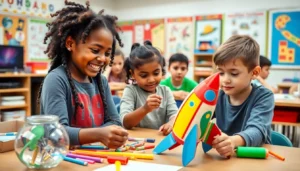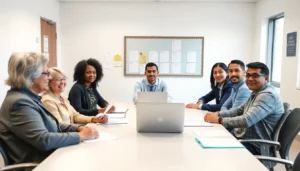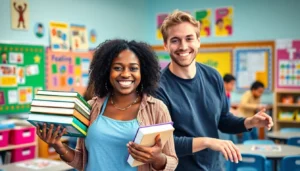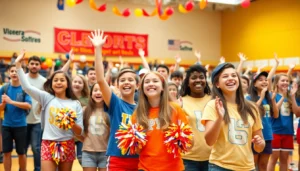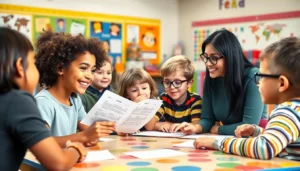Table of Contents
ToggleIn a world where traditional classrooms often feel like a never-ending episode of a sitcom, alternative education steps in like the quirky sidekick ready to shake things up. This approach isn’t just a buzzword; it’s a revolution in learning that caters to diverse needs and sparks creativity. Forget the one-size-fits-all model—alternative education embraces individuality, offering unique paths that can turn the mundane into the extraordinary.
Imagine a learning environment where students thrive on their own terms, exploring subjects that ignite their passions. Whether it’s through homeschooling, unschooling, or innovative learning pods, alternative education champions the idea that there’s no single way to learn. It’s about breaking free from the confines of traditional schooling and discovering what truly resonates. So, buckle up as we dive into the vibrant world of alternative education and uncover its meaning, benefits, and why it might just be the key to unlocking a brighter future for learners everywhere.
Understanding Alternative Education Meaning
Alternative education encompasses various teaching methods that diverge from traditional schooling. These approaches prioritize individualized learning experiences, allowing students to pursue their interests and strengths.
The Definition of Alternative Education
Alternative education refers to educational practices that offer non-traditional systems for learning. This model includes methods such as Montessori, Waldorf, and democratic schools. Students engage in self-directed learning, emphasizing critical thinking and creativity. Flexibility in curriculum design fosters an environment that encourages exploration and personal growth. Many learners thrive in alternative settings, as they cater to unique learning styles and needs.
Historical Context of Alternative Education
Alternative education has roots tracing back to the 19th century. Reformers like John Dewey championed experiential learning, advocating for education that prepares individuals for active citizenship. The rise of progressive education movements in the early 20th century further popularized this approach. In the latter half of the century, alternative education gained momentum, with increased interest in non-conventional methods. The growth of homeschooling and unschooling movements in the late 20th century marked a significant shift in educational philosophies, prompting a reevaluation of traditional approaches to learning.
Types of Alternative Education
Alternative education encompasses various approaches, each designed to meet the diverse needs of learners. Several popular models illustrate the flexibility and effectiveness of these methods.
Montessori Method
The Montessori method emphasizes self-directed learning. Students choose activities from a set of options, allowing them to learn at their own pace. Mixed-age classrooms encourage peer learning, fostering collaboration. Teachers serve as guides, facilitating rather than dictating the learning process. This approach promotes independence and critical thinking skills. With a focus on hands-on materials, learners engage deeply with concepts. The method has proven effective in cultivating a love for learning, encouraging lifelong curiosity.
Waldorf Education
Waldorf education nurtures creativity and imagination. Rooted in the philosophies of Rudolf Steiner, it prioritizes holistic development—emotional, social, and intellectual. Students experience a rich curriculum that includes arts, music, and practical skills, integrating all subjects. Lessons often draw from storytelling, connecting students to cultural and historical contexts. Teachers stay with the same group for several years, fostering strong relationships. This continuity supports a deeper understanding of concepts as learners progress through grades.
Sudbury Schools
Sudbury schools champion student autonomy in education. Each learner sets their own goals and schedules, emphasizing personal responsibility. Democratic governance allows students to influence school policies through voting. This structure cultivates a sense of community and belonging. They pursue interests freely, which fosters intrinsic motivation. Additionally, without grades or standardized tests, learners explore subjects without pressure. The Sudbury model promotes critical thinking, preparing students for real-world challenges.
Benefits of Alternative Education
Alternative education offers several advantages, emphasizing individualized learning paths and personal development.
Personalized Learning Approaches
Customized learning experiences cater to unique student needs. Students in alternative education settings often receive tailored instruction that matches their learning styles and paces. This approach allows for deeper engagement with the material. Individualized attention enhances understanding and retention of knowledge. Importantly, parents can play a significant role, participating in their child’s education and decision-making processes. Research shows personalized learning not only improves academic performance, but also boosts students’ confidence in their abilities.
Fostering Creativity and Independence
Creativity thrives in alternative education environments. Students explore subjects through innovative methods, integrating arts and hands-on activities into their lessons. This exploration encourages self-expression, allowing learners to engage with the world around them more meaningfully. Independence also flourishes, as students make decisions about their learning processes and goals. By fostering critical thinking and problem-solving skills, alternative education prepares students for real-life challenges. Programs that emphasize creativity and independence lead to well-rounded individuals capable of navigating complex situations.
Criticisms of Alternative Education
Alternative education faces scrutiny from various critics. Concerns arise regarding its effectiveness compared to traditional systems.
Lack of Standardization
Lack of standardization poses a significant challenge. Different alternative education models implement unique curricula and practices, leading to inconsistency in educational quality. Students in various programs might not acquire the same foundational knowledge, resulting in gaps in their education. Additionally, absence of standardized assessments creates difficulties in measuring student progress. Critics argue that this scenario can hinder students’ competitiveness in higher education or workforce environments. Without uniform guidelines, accountability can become a critical issue, causing disparities between students from alternative and traditional systems.
Accessibility and Affordability Issues
Accessibility and affordability represent major barriers for many families. Alternative education options, like private institutions or specialized programs, often come with high tuition fees. Some families may struggle to finance these alternatives, limiting their access to enhanced educational experiences. Public funding for alternative education programs varies, leading to inconsistencies in availability across regions. Consequently, lower-income families might feel excluded from these opportunities. Critics highlight that a lack of diverse options can perpetuate educational inequities, as students from disadvantaged backgrounds may not receive the same opportunities to benefit from alternative education approaches.
Alternative education represents a dynamic shift in how learning is approached. By prioritizing individual needs and fostering creativity, it offers a refreshing departure from traditional methods. This educational model not only encourages self-directed exploration but also nurtures critical thinking and problem-solving skills essential for success in today’s world.
While it faces challenges such as standardization and accessibility, the potential benefits of personalized learning experiences are profound. As educational landscapes continue to evolve, alternative education stands as a promising avenue for those seeking a more tailored and engaging approach to learning. Embracing this model could lead to a more inclusive and innovative future for education.
